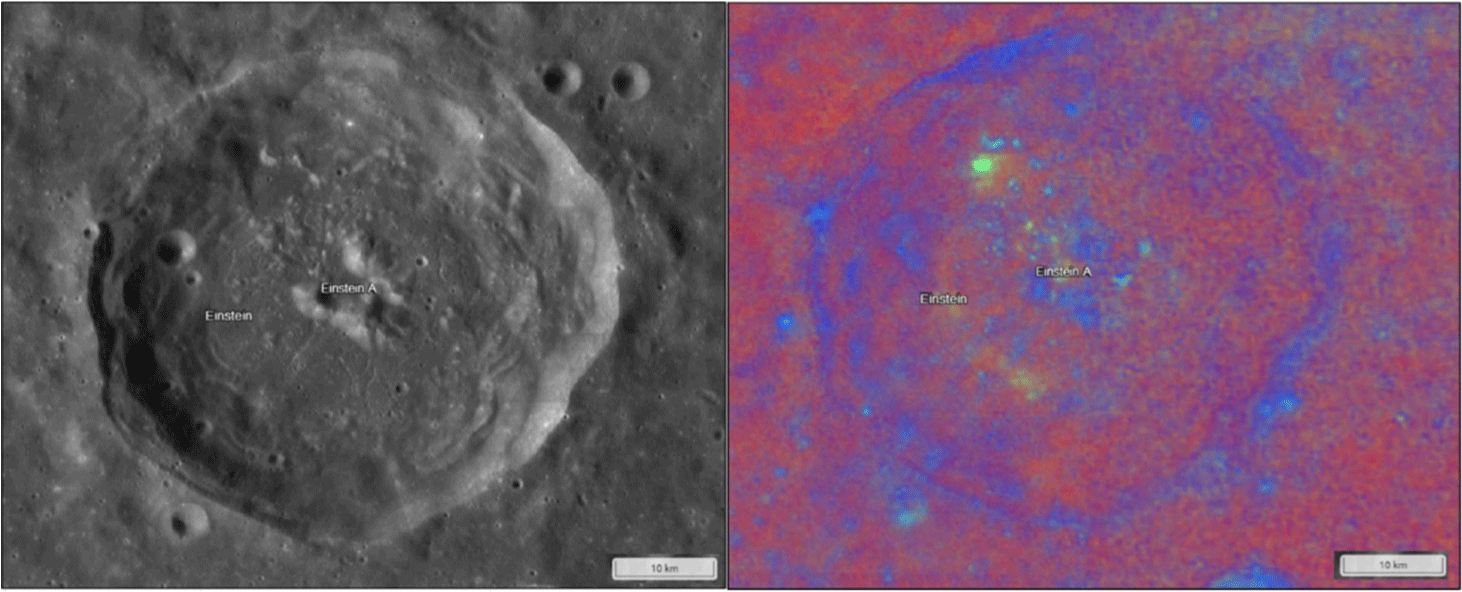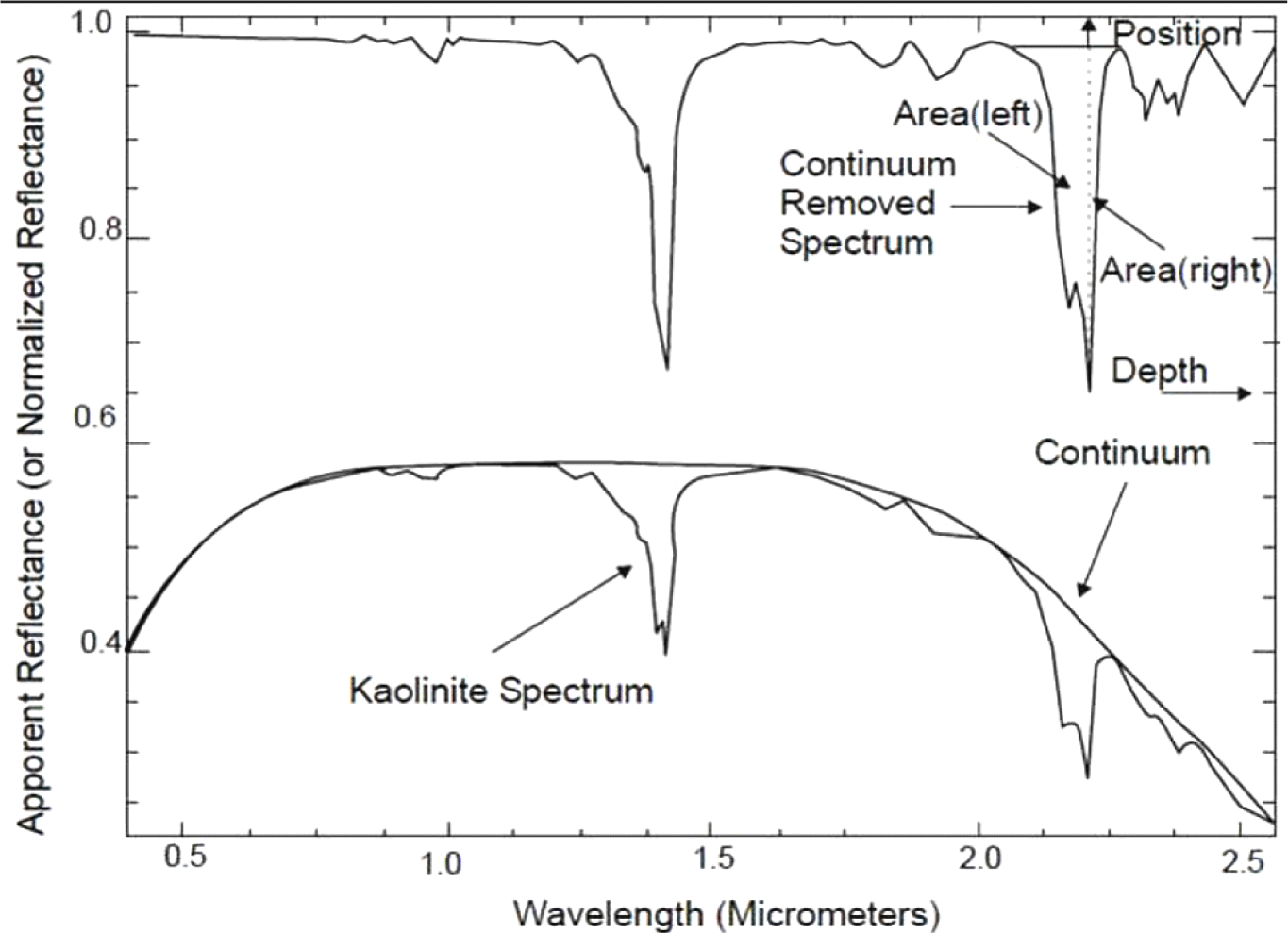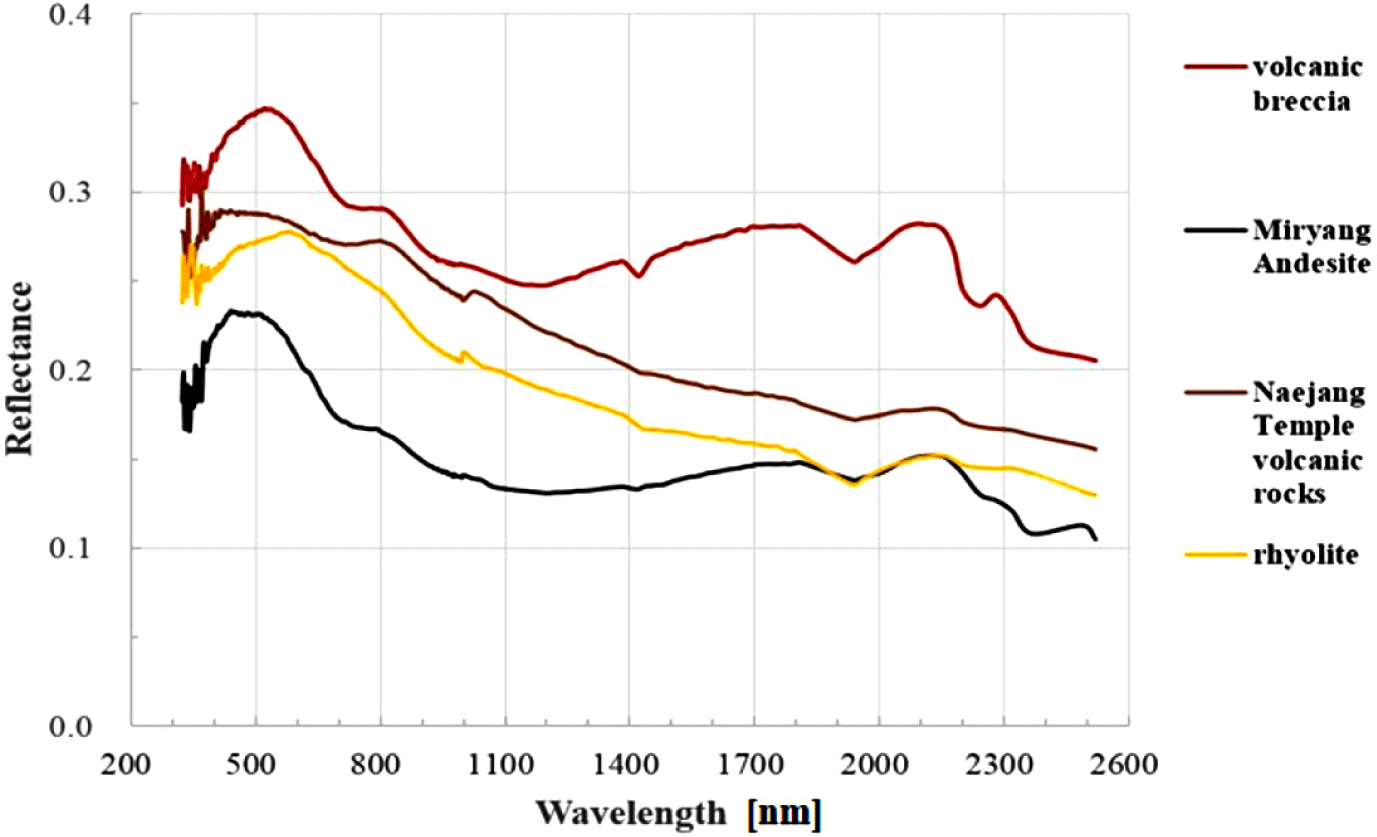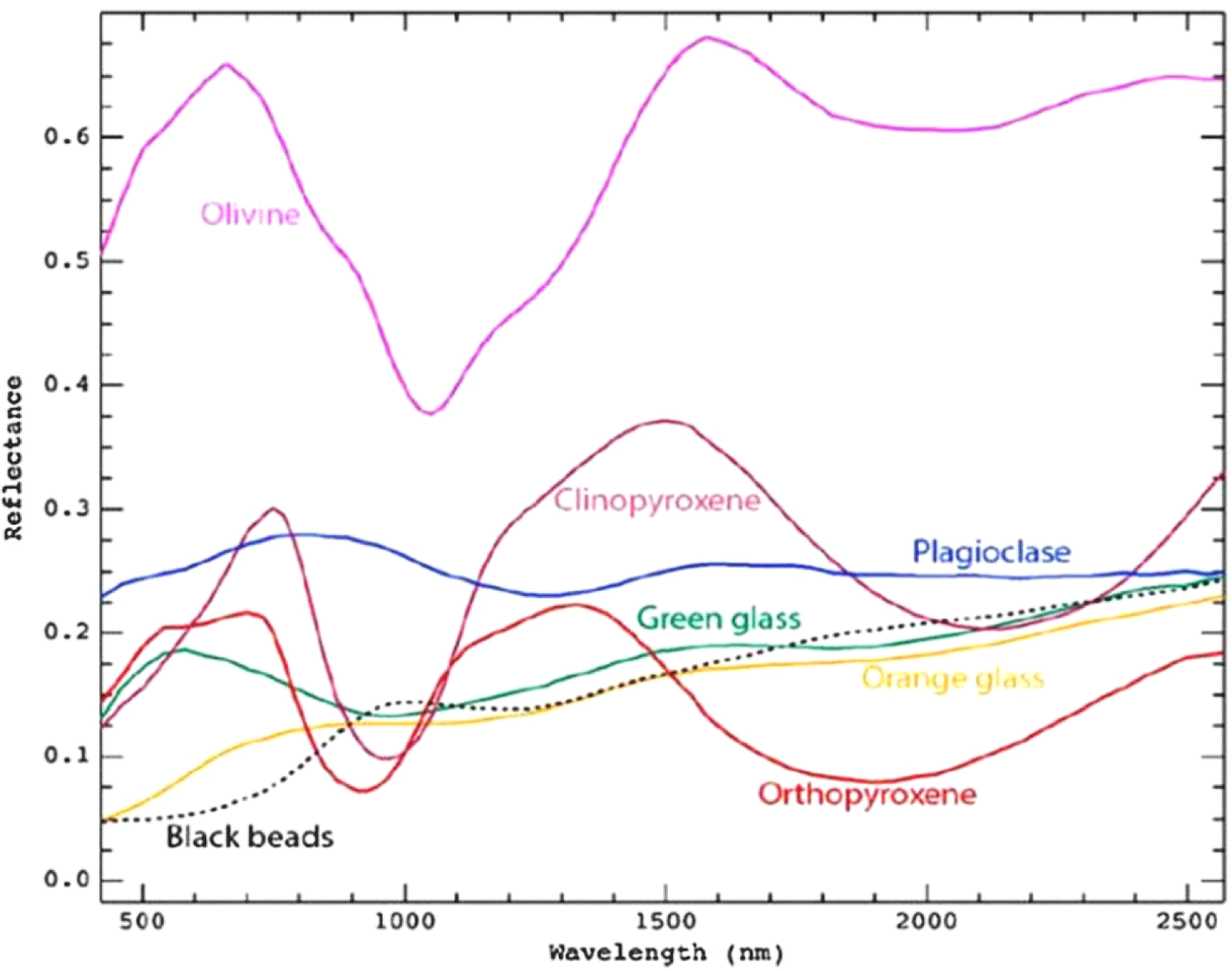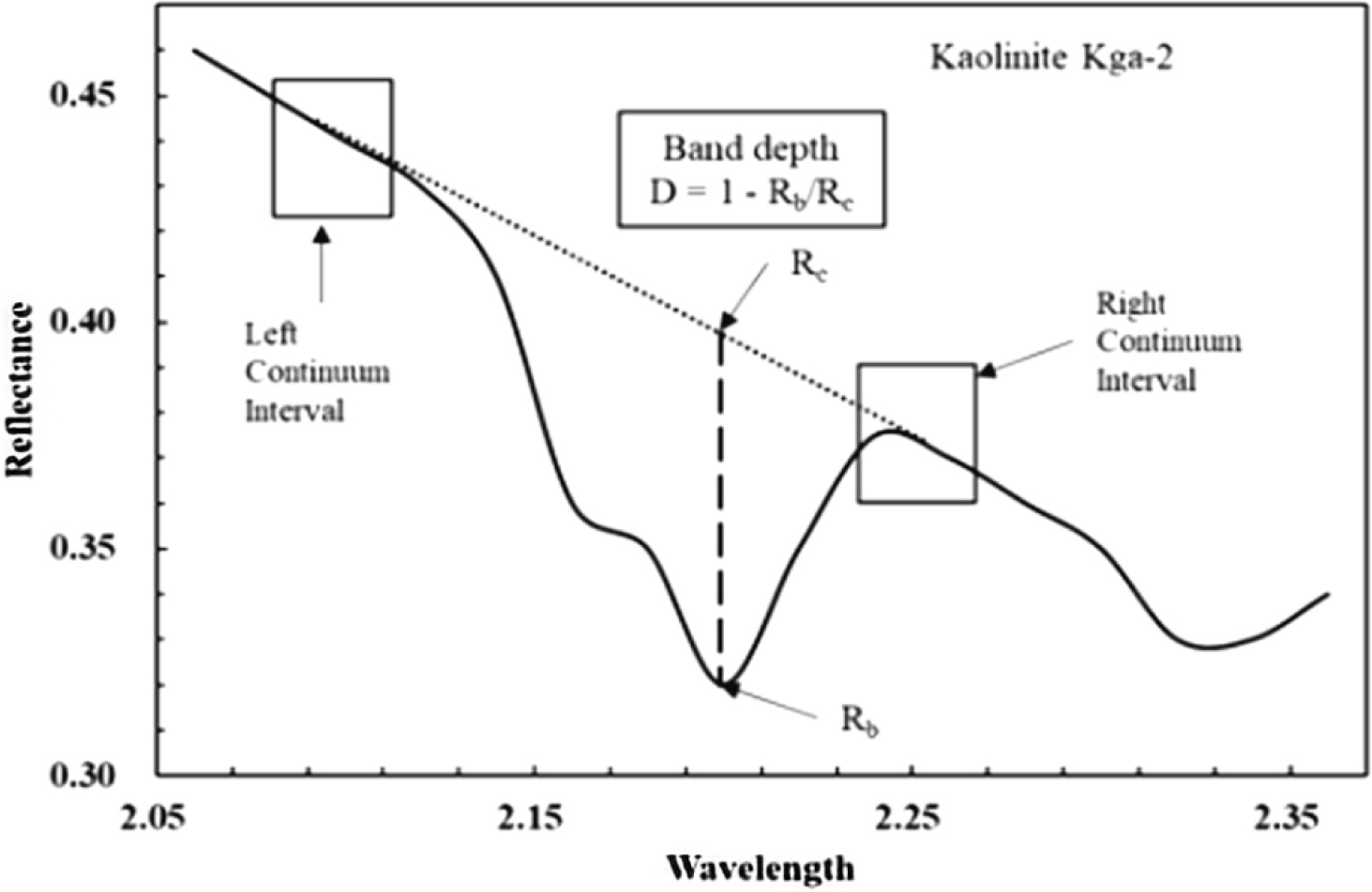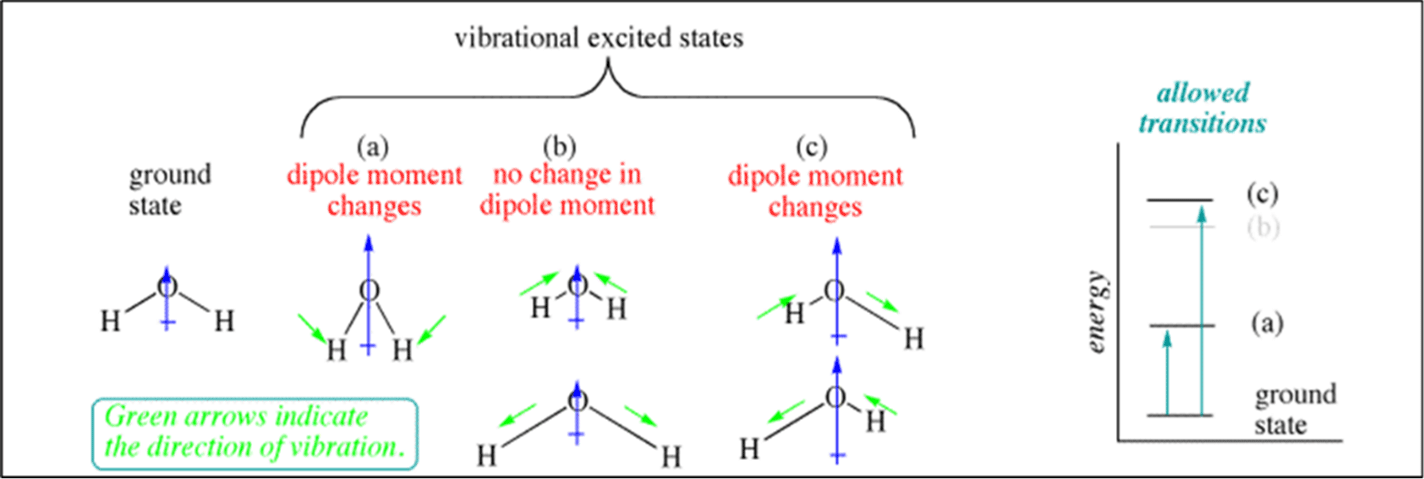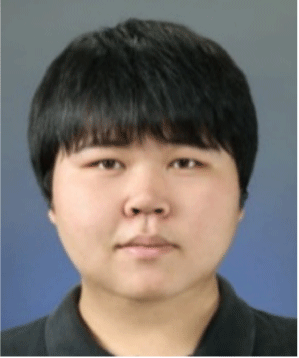기술논문
우주탐사에서의 가시광-근적외선 분광 자료 분석 기법
이응석
1
, 김경자
2,†
, 홍익선
2
, 김수연
2,3
Analysis Methods of Visible and Near-Infrared (VNIR) Spectrum Data in Space Exploration
Eung Seok Yi
1
, Kyeong Ja Kim
2,†
, Ik-Seon Hong
2
, Suyeon Kim
2,3
1Department of Astronomy, Space Science and Geology, Chungnam National University, Daejeon 34134, Korea
2Korea Institute of Geoscience and Mineral Resources, Daejeon 34132, Korea
33Department of Geophysical Exploration, University of Science and Technology, Daejeon 34113, Korea
†Corresponding author : Kyeong Ja Kim, Tel : +82-42-868-3669, E-mail :
kjkim@kigam.re.kr
© Copyright 2023 The Korean Space Science Society. This is an Open-Access article distributed under the terms of the
Creative Commons Attribution Non-Commercial License (http://creativecommons.org/licenses/by-nc/4.0/) which permits
unrestricted non-commercial use, distribution, and reproduction in any
medium, provided the original work is properly cited.
Received: Mar 21, 2023; Revised: Apr 02, 2023; Accepted: Apr 10, 2023
Published Online: May 31, 2023
요 약
우주탐사에서 분광관측은 대상의 구성 성분과 물리적 특성을 이해하는 데 유용한 방법이다. 분광 자료 분석에는 여러 가지 방법이 있으며, 관측 대상과 파장대역에 따라 차이가 있다. 본 논문에서는 달 탐사에서 주로 적용하는 가시광-근적외선(visible & near-infrared, VNIR) 분광 자료 분석 방법에 대해 소개한다. 주요 분석 방법에는 가색상 비율(false color ratio) 영상 처리, 반사도 유형(reflectance pattern) 분석, 통합 대역 깊이(integrated band depth, IBD) 계산이 있으며, 분석 이전의 전처리로는 연속체 제거(continuum removal)가 있다. 이러한 분광 분석 방법들은 가시광-근적외선 영역에서 나타나는 달 표면의 광물 특성을 이해하는데 도움이 되며, 화성과 같은 다른 천체에도 적용할 수 있다.
Abstract
In space exploration, spectroscopic observation is useful for understanding objects' composition and physical properties. There are various methods for analyzing spectral data, and there are differences depending on the object and the wavelength. This paper introduces a method for analyzing visible & near-infrared (VNIR) spectral data, which is mainly applied in lunar exploration. The main analysis methods include false color ratio image processing, reflectance pattern analysis, integrated band depth (IBD) processing, and continuum removal as preprocessing before analysis. These spectroscopic analysis methods help to understand the mineral properties of the lunar surface in the VNIR region and can be applied to other celestial bodies such as Mars.
Keywords: 분광학; 가시광-근적외선; 가색상 비율; 반사도; 통합 대역 깊이
Keywords: Spectroscopy; visible & near-infrared; false color ratio; reflectance; integrated band depth
1. 서론
인류의 우주탐사는 현재까지 몇 개의 착륙선, 로버 임무를 제외하고 모두 원격탐사로 수행되었다. 2022년 발사한 우리나라 최초의 달 탐사선 다누리 호도 원격탐사의 범주에 해당한다. 원격탐사의 특성상 전자기파를 매개체로 대상의 물리적 특성을 알아내며, 관측 대상과 목적에 따라 다양한 파장대역에서 정보 수집과 분석이 이루어진다. 달 탐사에서는 주로 영상 촬영과 분광 관측이 이루어지며, 그 중에서 분광관측은 달 표면의 구성성분을 이해하는데 필수적이다. 달 표면의 분광관측은 파장대역에 따라 크게 γ-선과 x-선, 가시광선과 적외선 두 가지로 분류할 수 있으며, γ-선과 x-선은 구성 원소, 가시광선과 적외선은 구성 광물을 구분하는데 적합하다. 이러한 분광관측은 달 탐사 이외에 태양계 내 행성과 위성 그리고 소행성, 혜성과 같은 소천체 탐사에서도 수행되고 있다.
달을 대상으로 가시광과 근적외선(visible & near-infrared, VNIR) 분광관측 연구는 매우 많지만, 대표적으로는 특정 지형에서의 광물 분포와 상대적 층서, 기원과 진화, 휘발성 물질 일변화 특성 등 여러 주제로 수행되고 있다[1–7]. 또한 원격탐사의 다음 단계로 진행될 현장탐사에서는 분광관측을 수행하여 착륙지 지역에서 활용할 수 있으며, 이는 자원에 대한 정성적, 정량적 식별을 통해 현지자원활용(in-situ resources utilization, ISRU)으로 진행할 수 있다[8–10].
분광관측 자료의 처리와 분석은 여러 방법이 있으며, 달 탐사에서 사용하는 기본적인 방법들에는 가색상 비율(false color ratio) 영상 분석, 반사도 유형(reflectance pattern) 분석과 전처리 과정인 연속체 제거(continuum removal), 통합 대역 깊이(integrated band depth, IBD) 분석 등이 있다. 본 논문에서는 달 탐사에서 사용하는 VNIR 분광관측 자료 처리 기법 몇 가지에 대해 소개한다.
2. Visible and Near-Infrared (VNIR) 분광 원리
분광학(spectroscopy)은 전자기파를 파장에 따라 나누어 관측 대상의 물리적 특성을 연구하는 학문이다. 관측 방법은 크게 두 가지로 매우 멀리 있는 항성과 같은 점광원에 대한 단일 스펙트럼을 얻어내는 것과 관측 대상의 특정 영역의 모든 스펙트럼을 얻어내는 영상 스펙트럼이 있다. 달 탐사에서는 주로 VNIR 영역에서 영상 스펙트럼 관측 방법이 수행되며, 채널의 집적도와 수에 따라 다중 분광(multi-spectral)과 초분광(hyper-spectral)으로 분류한다. 또한 VNIR 분광관측은 관측 대상의 물질 상태(고체, 기체, 액체)에 상관없이 물리적 특성을 알아낼 수 있는 장점이 있다[11].
달 탐사에서의 VNIR 분광 원리는 태양과 달 표면 구성 물질 간의 상호 작용을 분석하는 것이다. 태양에서 방출된 복사에너지가 달에 도달하여 표면 암석을 구성하는 분자와 원자에 에너지를 전달한다. 에너지를 흡수한 분자와 원자들은 진동하게 되고, 전자의 에너지 준위가 상승하여 들뜬 상태가 되었다가 바닥 상태로 안정화되면서 에너지를 방출한다. 이때 분자의 구조에 따라 진동이 달라지며 그에 따른 에너지 준위 차이로 인해 같은 분자라도 방출되는 에너지의 차이가 발생한다(Fig. 1). 대표적인 예시로 분자간 각도와 거리에 따라 진동이 달라지는 물과 이산화탄소가 있다[11–13]. 이와 같은 원리로 달 표면의 암석을 구성하는 광물은 결정구조에 따라 고유파장을 가지고 있어 방출되는 에너지의 파장이 달라지며, 이러한 물리적 특성은 스펙트럼 상에서 흡수선의 형태로 나타난다[14,15]. 예시로 철 광물에 포함된 제1철(ferrous, Fe2+) 이온과 제2철(ferric, Fe3+) 이온이 있으며, 400–1,000 nm 파장영역에 흡수선을 나타낸다[16].
3. 가색상 비율 영상(False Color Ratio Image)
분광 영상은 채널마다 할당된 좁은 파장대역의 전자기파 정보들을 가지고 있다. 그래서 사람의 눈으로 인식하는 가시광선 영역 대신 다른 파장의 정보를 가시광선 색으로도 표현할 수 있다. 이런 방식으로 사람의 눈으로 볼 수 없는 파장대역의 영상을 사람이 인식하는 색으로 표현하거나, 혹은 가시광선 파장에서 나타나는 본래의 색과 다르게 영상에서 표현하는 것을 가색상(false color)이라고 한다. 가색상 영상은 인위적으로 특정 파장 대역에 색을 지정할 수 있어 사용자가 원하는 관측대상의 물리적 특성을 쉽게 눈으로 확인할 수 있는 장점이 있다.
대표적인 예시로 1994년 미국 항공우주국(National Aeronautics and Space Adm¬inistration, NASA)에서 발사한 클레멘타인(Clementine) 궤도선의 자외선-가시광선 카메라(ultra violet-visible camera, UV-VIS camera) 탑재체가 촬영한 영상이다(Fig. 2). 이 영상은 암석의 고유파장과 기준파장의 비를 계산하여 적색, 녹색, 청색 3개 채널로 각각 가색상 비율 영상을 지정하여 표현하였으며, 각 채널이 나타내는 물리적 특성은 Table 1과 같다[17–20]. 이처럼 3개의 색조합으로 가색상 비율 영상을 표현하는 것은 가색상 비율 합성(false color ratio composite)이라고도 부른다[1,21,22].
Fig. 2.
The 750 nm image of lunar reconnaissance orbiter camera (LROC) wide angle camera (WAC) (left). The false color composite of Clementine ultra violet – visible (UV-VIS) camera (right) [2,16-20]. Location is the Einstein crater (16.6°N, 88.65°W).
Download Original Figure
Table 1.
The false color ratio (RGB) [2,16-20]
|
Color |
Ratio |
Explanation |
|
R (Red) |
750 nm /415 nm |
Soil maturity |
|
G (Green) |
750 nm /950 nm |
Mafic rocks |
|
B (Blue) |
415 nm /750 nm |
the Mare concentration of the ilmenite [FeTiO3] or the fresh soils, Fe-rich, higher Ti |
|
Yellow, Orange |
|
Fe-rich, lower Ti |
Download Excel Table
4. 반사도 유형(Reflectance Pattern)과 연속체 제거(Continuum Removal)
4.1 연속체 분광과 연속체 제거 분광
연속체는 광물 스펙트럼에서 나타나는 현상으로 관측하는 파장영역 전체에 걸쳐 선형 혹은 비선형으로 추세가 나타난다. 연속체가 나타나는 원인은 흑체복사의 영향, 광물 고유 특성 등 여러 가지가 있을 수 있다. 또한 스펙트럼 흡수선의 깊이와 선폭 등 정량적인 분석을 할 때 방해요소로 작용할 수 있어 제거하는 것이 좋다. 제거 방법은 관측 시기의 온도를 측정해서 흑체복사 곡선을 계산하여 제거하거나, 볼록 껍질(convex-hull) 알고리즘과 같은 수학적 기법 등을 사용하여 제거한다.
연속체 제거 전후의 스펙트럼의 예시로 지구에서 측정한 고령석(Kaolinite) 스펙트럼을 Fig. 3에 나타냈다. 그림에서 아래의 스펙트럼이 연속체가 포함되어 있는 스펙트럼이고, 위가 연속체를 제거한 스펙트럼이다. 연속체를 제거함으로써 흡수선에 대한 깊이와 면적 등을 보다 더 정확하게 정량적으로 계산할 수 있다.
4.2 지구 표면의 반사도 유형
지구는 달과 달리 물과 대기가 존재하므로 많은 변수들이 발생한다. 스펙트럼에 물과 대기의 영향이 고스란히 나타나 대기보정 수행과 함수율에 따른 분광 특성 이해가 있어야 정확한 분석이 가능하다. 지구 광물 반사도 유형 예시로 지구 화산암의 반사도 유형 스펙트럼으로 각 파장에 대한 흡수선을 파악해 물리적 특성을 추론할 수 있다(Fig. 4)[23]. 빨강색은 백악기 화산 각력암(volcanic breccia), 검정색은 백악기 밀양 안산암(andesite), 갈색은 백악기 내장사 화산암류, 노랑색은 백악기 유문암(rhyolite)을 가리킨다. 이들은 서로 복합된 산출상을 보여주며, 몇 번의 분출 활동이 이루어진 것으로 보인다[24,25].
4.3 달 표면의 반사도 유형
달 광물의 반사도 스펙트럼은 아폴로 계획(Apollo program)과 같은 착륙 임무의 귀환시료 측정과 궤도선의 분광관측을 통해 얻을 수 있다. 귀환시료는 실험실에서 측정하기 때문에 고해상도의 정확한 스펙트럼을 얻을 수 있는 장점이 있으나, 착륙지가 한정되어 있기 때문에 다양한 시료의 정보를 확인할 수 없는 한계가 있다. 궤도선의 분광관측은 귀환시료와는 반대로 해상도가 비교적 낮고 신호 대 잡음비가 낮아 부정확도가 존재하지만, 다양한 지역을 관측할 수 있어 여러 유형의 스펙트럼을 얻어낼 수 있다. 그래서 각 측정방법의 단점을 보완하기 위해 귀환시료와 궤도선이 관측한 스펙트럼을 비교하는 방법도 존재한다[26–28]. 대표적인 귀환시료 측정시설에는 NASA 지원으로 설립된 미국 브라운 대학교(Brown University)의 반사도 실험 연구실(reflectance experiment laboratory, RELAB)이 있으며, 측정한 자료들은 분광 라이브러리 형태로 배포되고 있다. RELAB 분광 라이브러리에서 달 귀환시료 중 대표적인 광물 스펙트럼은 Fig. 5에서 보여준다. 감람석(olivine), 단사휘석(clinopyroxene), 사방휘석(orthopyroxene) 그리고 사장석(plagioclase)이 주된 조성 광물이며 그 외에는 유리질이 있다.
Fig. 5.
The reflectance spectra of the lunar samples in the Brown university reflectance experiment laboratory (RELAB) spectral library [29,30].
Download Original Figure
5. 적분 대역 깊이(Integrated Band Depth, IBD)
초분광 자료는 스펙트럼에 나타나는 흡수선의 선폭보다 초분광에서 할당된 채널의 폭이 좁기 때문에 하나의 채널만으로 흡수선의 특징을 대표한다고 할 수 없다. 이에 대한 해결 방안으로 흡수선의 특징이 나타나는 채널 영역들을 통합하여 흡수선 영역의 깊이를 계산하는 방법이 사용되며 통합 대역 깊이(integrated band depth, IBD)라고 부른다. 달 탐사에서 사용하는 대표적인 초분광 자료는 Moon Mineralogy Mapper(M3)가 있는데 일반적으로 IBD를 적용할 때는 달에 풍부한 감람석과 휘석의 흡수선이 나타나는 1,000, 2,000 nm 파장을 대상으로 한다[29–34]. 많은 연구자들이 사용하기 때문에 IBD1000, IBD2000으로 불리며 방정식Eq. (1), (2)는 다음과 같다.
n은 계산에 사용할 채널 수를 의미하고, R은 반사도, Rc는 연속체의 반사도이다. 단순하게 표현하면 IBD는 각 채널별 대역 깊이의 총합이라고 할 수 있다(Fig. 6)[35]. 또한 앞서 언급했던 가색상 비율 영상과 반사도 유형 및 연속체 제거가 모두 적용되므로 다방면에서 분석할 수 있는 장점이 있다.
이처럼 계산된 통합 대역 깊이 영상은 다른 영상들과 조합하여 가색상 비율로도 나타낼 수 있으며, 특정 흡수선에 대한 정보를 좀 더 강조할 수 있는 특징이 있다.
6. 요약 및 결론
우주탐사에서 이루어지는 분광관측에서 VNIR 파장영역의 자료 처리 및 분석 방법에 대해 소개하였다. 이 방법들은 주로 달 탐사에서 적용되며 화성이나 소행성 등 다른 태양계 천체들에도 적용 가능하다. 하지만, 사전에 대상 천체의 지질과 광물과 같은 물리적, 화학적 이해가 선행되어야 한다. 또한 향후 우주탐사의 중요한 화두인 ISRU에서도 유용하게 사용될 것으로 기대한다.
감사의 글
이 연구는 정부(과학기술정보통신부)의 재원으로 한국연구재단의 지원을 받아 수행되었습니다(NRF-2022R1A2C1092602). 또한 이 연구는 정부(과학기술정보통신부)의 재원으로 한국지질자원연구원의 지원을 받아 수행되었습니다(KIGAM, 23-3216).
References
Pieters CM, Hanna KD, Cheek L, Dhingra D, Prissel T, et al., The second conference on the lunar highlands crust and new directions. The distribution of Mg-spinel across the Moon and constraints on crustal origin, Am. Mineral. 99, 1893-1910 (2014).


Thesniya PM, Rajesh VJ, Pyroxene chemistry and crystallization history of basaltic units in the Mare Humorum on the nearside of the Moon: implications for the volcanic history of the region, Planet. Space Sci. 193, 105093 (2020).


Wöhler C, Grumpe A, Berezhnoy AA, Feoktistova EA, Evdokimova NA, et al., Temperature regime and water/hydroxyl behavior in the crater Boguslawsky on the Moon, Icarus 285, 118-136 (2017).


Hong IS, Yi Y, Kim E, Lunar pit craters presumed to be the entrances of lava caves by analogy to the Earth lava tube pits, J. Astron. Space Sci. 31, 131-140 (2014).


Yi ES, Kim KJ, Choi YR, Kim YH, Lee SS, et al., Investigation of reflectance distribution and trend for the double ray located in northwest of Tycho crater, J. Astron. Space Sci. 32, 161-166 (2015).


Kim S, Yi Y, Hong IS, Sohn J, Solar insolation effect on the local distribution of lunar hydroxyl, J. Astron. Space Sci. 35, 47-54 (2018).


Djachkova MV, Litvak ML, Mitrofanov IG, Sanin AB, Selection of Luna-25 landing sites in the south polar region of the Moon, Sol. Syst. Res. 51, 185-195 (2017).


Jawin ER, Valencia SN, Watkins RN, Crowell JM, Neal CR, et al., Lunar science for landed missions workshop findings report, Adv. Earth Space Sci. 6, 2-40 (2018).


Kim KJ, Wöhler C, Ju GH, Lee SR, Rodriguez AP, et al., Korean lunar lander – concept study for landing-site selection for lunar resource exploration, Int. Arch. Photogramm. Remote Sens. Spat. Inf. Sci. 41, 417-423 (2016).


Stuart BH, Infrared Spectroscopy: Fundamentals and Applications (John Wiley & Sons, Hoboken, NJ, 2004).

Heiken G, Vaniman D, French BM, Lunar Sourcebook: A User's Guide to the Moon (Cambridge University Press, Cambridge, UK, 1991).

Rencz AN, Ryerson RA, Manual of Remote Sensing, Remote Sensing for the Earth Sciences (John Wiley & Sons, Hoboken, NJ, 1999).

Son YS, Kim KE, Yoon WJ, A review of remote sensing techniques and applications for geoscience and mineral resources, J. Korean Soc. Miner. Energy Resour. Eng. 52, 429-457 (2015).


Qiao L, Head JW, Xiao L, Wilson L, Dufek JD, The role of substrate characteristics in producing anomalously young crater retention ages in volcanic deposits on the Moon: morphology, topography, subresolution roughness, and mode of emplacement of the Sosigenes lunar irregular mare patch, Meteorit. Planet. Sci. 53, 778-812 (2018).


Robinson M, Riner M, Advances in lunar science from the Clementine mission: a decadal perspective, J. Earth Syst. Sci. 114, 669-686 (2005).


Kim S, Kim KJ, Yi Y, Investigation on lunar landing candidate sites for a future lunar exploration mission, Int. J. Aeronaut. Space Sci. 23, 221-232 (2022).


Yi ES, Kim KJ, Wöhler C, Berezhnoy AA, Kim YH, et al., Petrological and mineralogical characteristics of exposed materials on the floors of the Lavoisier and surrounding craters, Remote Sen. 14, 4313 (2022).


Meer F, Analysis of spectral absorption features in hyperspectral imagery, Int. J. Appl. Earth Obs. Geoinform. 5, 55-68 (2004).


Chi K, Lee SS, Lee H, Spectral Library of Surface Cladding – Rock, Vegetation, Artificial Structure (KIGAM, Daejeon, Korea, 2007).

Blewett DT, Lucey PG, Ray Hawke B, Jolliff BL, Clementine images of the lunar sample-return stations: refinement of FeO and TiO
2 mapping techniques, J. Geophys. Res. Planets 102, 16319-16325 (1997).


Nagaoka H, Takeda H, Karouji Y, Ohtake M, Yamaguchi A, et al., Implications for the origins of pure anorthosites found in the feldspathic lunar meteorites, Dhofar 489 group, Earth Planet. Space 66, 115 (2014).


Pieters C, McCord TB, Characterization of lunar mare basalt types: I. a remote sensing study using reflection spectroscopy of surface soils, in 7th Lunar and Planetary Science Conference Proceedings, Houston, TX, 15-19 Mar 1976.

Besse S, Sunshine JM, Gaddis LR, Volcanic glass signatures in spectroscopic survey of newly proposed lunar pyroclastic deposits, J. Geophys. Res. Planets 119, 355-372 (2014).


Grumpe A, Wöhler C, Berezhnoy AA, Shevchenko VV, Time-of-day-dependent behavior of surficial lunar hydroxyl/water: observations and modeling, Icarus 321, 486-507 (2019).


Lemelin M, Lucey PG, Miljković K, Gaddis LR, Hare T, et al., The compositions of the lunar crust and upper mantle: spectral analysis of the inner rings of lunar impact basins, Planet. Space Sci. 165, 230-243 (2019).


Nettles JW, Staid M, Besse S, Boardman J, Clark RN, et al., Optical maturity variation in lunar spectra as measured by Moon Mineralogy Mapper data, J. Geophys. Res. Planets 116, E00G17 (2011).


Öhman T, Kramer GY, Kring DA, Characterization of melt and ejecta deposits of Kepler crater from remote sensing data, J. Geophys. Res. Planets 119, 1238-1258 (2014).


Clark RN, Swayze GA, Eric Livo K, Kokaly RF, Sutley SJ, et al., Imaging spectroscopy: Earth and planetary remote sensing with the USGS Tetracorder and expert systems, J. Geophys. Res. Planets 108, 5131 (2003).


